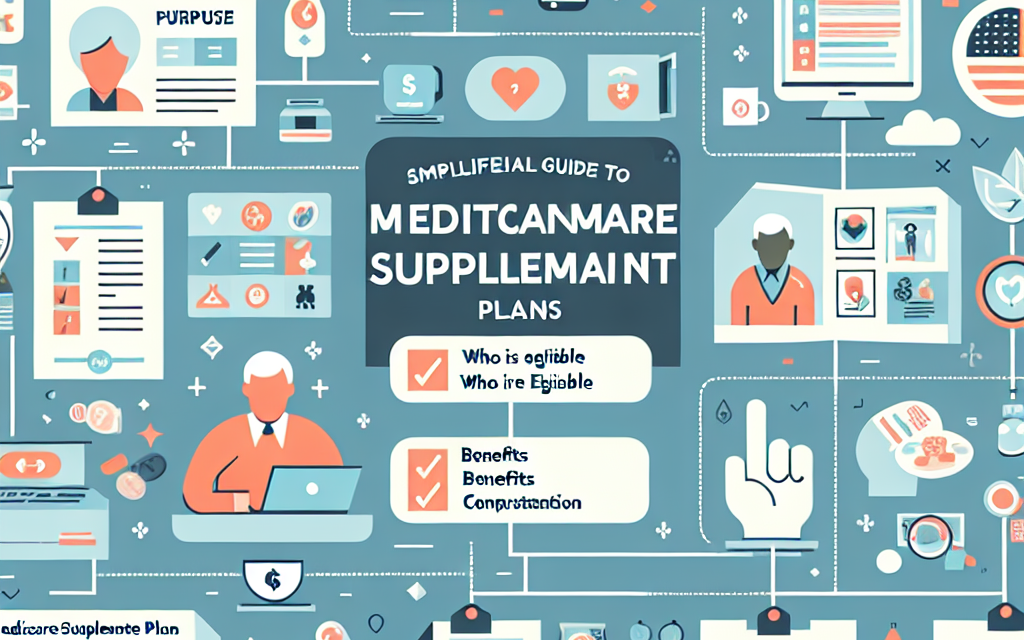Demystifying Medicare Supplement Plans: A Clear Guide
As the population ages, understanding healthcare options becomes increasingly important. Medicare, a federal health insurance program primarily for individuals aged 65 and older, offers various plans to meet diverse healthcare needs. Among these options, Medicare Supplement Plans, also known as Medigap, play a crucial role in filling the gaps left by Original Medicare. This article aims to demystify Medicare Supplement Plans, providing a comprehensive guide that covers their purpose, types, eligibility, costs, and enrollment processes.
Understanding Medicare and Its Limitations
Before diving into Medicare Supplement Plans, it’s essential to understand the basics of Medicare itself. Medicare is divided into different parts, each serving a specific purpose:
- Part A: Hospital Insurance – Covers inpatient hospital stays, skilled nursing facility care, hospice, and some home health care.
- Part B: Medical Insurance – Covers outpatient care, doctor visits, preventive services, and some home health care.
- Part C: Medicare Advantage – A private insurance plan that includes coverage from both Part A and Part B, often with additional benefits.
- Part D: Prescription Drug Coverage – Provides coverage for prescription medications through private insurance plans.
While Medicare provides essential coverage, it does not cover all healthcare costs. Beneficiaries are often left with out-of-pocket expenses, including deductibles, copayments, and coinsurance. This is where Medicare Supplement Plans come into play.
What Are Medicare Supplement Plans?
Medicare Supplement Plans are private insurance policies designed to cover the out-of-pocket costs that Original Medicare does not cover. These plans are standardized and regulated by the federal government, ensuring that each plan offers the same basic benefits, regardless of the insurance company selling it. There are ten standardized Medigap plans, labeled A through N, each offering different levels of coverage.
For example, Plan F is one of the most comprehensive options, covering all out-of-pocket costs associated with Medicare Parts A and B. However, it is essential to note that Plan F is not available to new Medicare beneficiaries who became eligible after January 1, 2020. Instead, they can consider Plan G, which offers similar benefits but requires a small deductible.
Key Benefits of Medicare Supplement Plans
Medicare Supplement Plans provide several key benefits that can significantly enhance a beneficiary’s healthcare experience:
- Comprehensive Coverage: Medigap plans can cover a wide range of out-of-pocket costs, including copayments, coinsurance, and deductibles.
- Predictable Costs: With a Medigap plan, beneficiaries can better predict their healthcare expenses, as many plans cover most or all of the costs associated with Medicare services.
- Nationwide Acceptance: Medigap plans are accepted by any provider that accepts Medicare, giving beneficiaries flexibility in choosing healthcare providers.
- Guaranteed Renewability: As long as premiums are paid, Medigap plans cannot be canceled due to health issues, providing peace of mind for beneficiaries.
Types of Medicare Supplement Plans
As mentioned earlier, there are ten standardized Medicare Supplement Plans, each offering different levels of coverage. Here’s a closer look at each plan:
Plan A
Plan A is the most basic Medigap plan, covering the following:
- Part A coinsurance and hospital costs
- First three pints of blood
- Part A hospice care coinsurance or copayment
While it offers limited coverage, it can be a cost-effective option for those who do not anticipate high medical expenses.
Plan B
Plan B includes everything in Plan A, plus:
- Part A deductible
This plan is suitable for individuals who want to cover their hospital deductible but do not need extensive coverage.
Plan C
Plan C offers comprehensive coverage, including:
- All benefits of Plan B
- Part B coinsurance or copayment
- Skilled nursing facility coinsurance
- Part B deductible
- Foreign travel emergency care (up to plan limits)
However, like Plan F, it is not available to new beneficiaries after 2020.
Plan D
Plan D includes all benefits of Plan B, plus:
- Part B coinsurance or copayment
- Foreign travel emergency care (up to plan limits)
This plan is a good option for those who want more coverage than Plan B but do not need the extensive benefits of Plan C.
Plan F and Plan G
Plan F is the most comprehensive Medigap plan, covering all out-of-pocket costs associated with Medicare Parts A and B. However, it is not available to new beneficiaries after 2020. Plan G is similar to Plan F but requires beneficiaries to pay the Part B deductible. It has become a popular choice for new enrollees due to its extensive coverage.
Plan K and Plan L
These plans offer cost-sharing features, meaning beneficiaries pay a portion of their healthcare costs. Plan K covers 50% of certain costs, while Plan L covers 75%. They are suitable for those who want lower premiums and are willing to share some costs.
Plan M and Plan N
Plan M covers 50% of the Part A deductible and includes all other benefits of Plan D. Plan N requires copayments for certain office visits but offers lower premiums. Both plans are ideal for those looking for a balance between coverage and cost.
Eligibility and Enrollment in Medicare Supplement Plans
Understanding eligibility and enrollment is crucial for anyone considering a Medicare Supplement Plan. Here’s what you need to know:
Eligibility Criteria
To be eligible for a Medicare Supplement Plan, you must meet the following criteria:
- You must be enrolled in Medicare Part A and Part B.
- You must reside in the state where you are applying for the Medigap plan.
- You must be at least 65 years old or have a qualifying disability.
Open Enrollment Period
The best time to enroll in a Medicare Supplement Plan is during your Open Enrollment Period, which begins the first month you are 65 and enrolled in Medicare Part B. This period lasts for six months. During this time, you have guaranteed issue rights, meaning insurance companies cannot deny you coverage or charge higher premiums based on your health status.
Special Enrollment Periods
If you miss the Open Enrollment Period, you may still have options through Special Enrollment Periods (SEPs). SEPs can occur in various situations, such as:
- Moving to a new state
- Leaving a Medicare Advantage plan
- Becoming eligible for Medicaid
During these periods, you may have the right to purchase a Medigap plan without medical underwriting.
How to Enroll
Enrolling in a Medicare Supplement Plan is a straightforward process:
- Research and compare different Medigap plans available in your area.
- Contact insurance companies or use online comparison tools to get quotes.
- Complete the application process with the chosen insurance company.
- Pay the first premium to activate your coverage.
Costs Associated with Medicare Supplement Plans
Understanding the costs associated with Medicare Supplement Plans is vital for budgeting healthcare expenses. Here’s a breakdown of the various costs you may encounter:
Monthly Premiums
Medicare Supplement Plans require monthly premiums, which can vary significantly based on several factors:
- Plan Type: More comprehensive plans like Plan F typically have higher premiums than basic plans like Plan A.
- Location: Premiums can vary by state and even by zip code.
- Insurance Company: Different insurers may charge different premiums for the same plan.
On average, monthly premiums for Medigap plans can range from $100 to $300, depending on the factors mentioned above.
Out-of-Pocket Costs
While Medigap plans cover many out-of-pocket costs, beneficiaries may still incur some expenses, including:
- Part B deductible (if enrolled in Plan G or lower)
- Copayments for certain services (if enrolled in Plan N)
- Costs for services not covered by Medicare or Medigap plans
Rate Increases
It’s important to note that premiums for Medigap plans can increase over time. Insurers may raise rates based on factors such as:
- Inflation
- Increased healthcare costs
- Changes in the insurer’s claims experience
Beneficiaries should review their plans annually to ensure they are getting the best value for their coverage.
Choosing the Right Medicare Supplement Plan
Choosing the right Medicare Supplement Plan can be a daunting task, given the variety of options available. Here are some tips to help you make an informed decision:
Assess Your Healthcare Needs
Consider your current health status and anticipated healthcare needs. If you have chronic conditions or expect frequent medical visits, a more comprehensive plan like Plan G may be beneficial. Conversely, if you are generally healthy, a basic plan like Plan A may suffice.
Compare Plans and Premiums
Take the time to compare different Medigap plans and their associated premiums. Use online comparison tools or consult with a licensed insurance agent to get quotes from multiple insurers. Look for plans that offer the best balance of coverage and cost.
Consider the Insurer’s Reputation
Research the insurance companies offering Medigap plans in your area. Look for reviews and ratings from current policyholders to gauge customer satisfaction and claims handling. A reputable insurer can make a significant difference in your overall experience.
Understand the Enrollment Process
Be aware of the enrollment process and timelines. Enrolling during your Open Enrollment Period ensures you have guaranteed issue rights, making it easier to obtain coverage without medical underwriting.
Seek Professional Guidance
If you find the process overwhelming, consider seeking assistance from a licensed insurance agent or a Medicare counselor. They can provide personalized guidance based on your unique situation and help you navigate the complexities of Medicare Supplement Plans.
Conclusion
Medicare Supplement Plans play a vital role in enhancing the healthcare coverage of Medicare beneficiaries. By understanding the various types of plans, eligibility criteria, costs, and enrollment processes, individuals can make informed decisions that best suit their healthcare needs. As healthcare costs continue to rise, having a Medigap plan can provide peace of mind and financial security. Remember to assess your healthcare needs, compare plans, and seek professional guidance if necessary. With the right information and resources, you can navigate the world of Medicare Supplement Plans with confidence.





